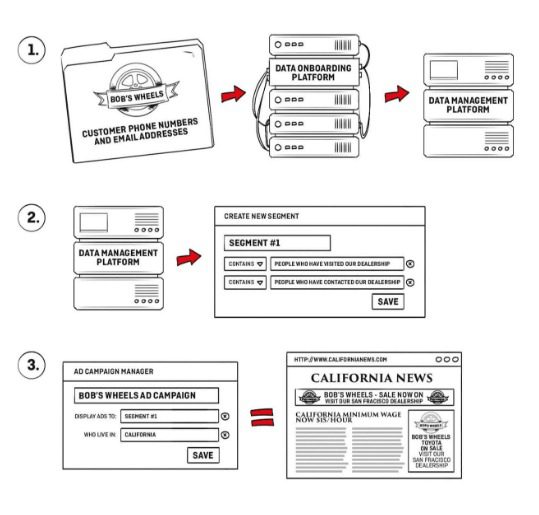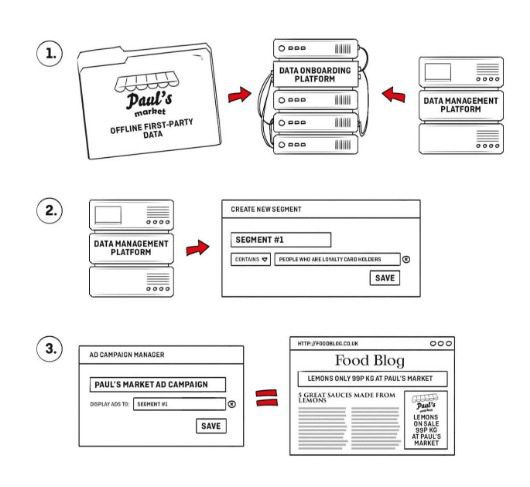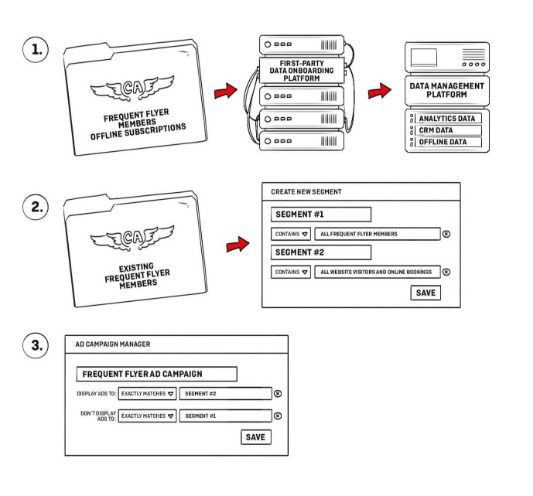 Going back just a few years, the hype over third-party data was in full swing. Back then, third-party data was seen as a way to reach more potential customers with the hope of increasing sales.
Going back just a few years, the hype over third-party data was in full swing. Back then, third-party data was seen as a way to reach more potential customers with the hope of increasing sales.
While third-party data still has its value, today there’s a bigger focus on utilizing first-party data. This is because third-party data is used by everyone (including your competitors), and people are generally more skeptical of online advertising. It’s increasingly harder to get users to engage with ads, unless, of course, they’re relevant to each individual consumer and provide some amount of value.
But do relevant ads actually produce results? Are they more effective than non-relevant ads?
It turns out they are.
A 2014 survey conducted by Yahoo! and Interscope Research found the following:
-
People spend 25% more time fixating on ads that are personally relevant to them versus those that are not.
-
Pupil dilation increases by 27%, which is a strong indicator of increased cognition of the ad and means people are processing the key messages to a greater extent.
Marketers and advertisers have used various forms of personalization for some time now, but it’s mainly been based on online data only. However, its true potential lies in combining offline data with online data via a process known as first-party data onboarding.
What Can Companies Achieve By Onboarding Offline And Online Data?
Most companies these days collect both offline and online data. By combining the two, you can achieve the following:
-
Find and target your offline customers and prospective customers on digital channels across different devices;
-
Increase conversions by targeting and retargeting ads to users across online channels;
-
Display relevant ads to more users without sacrificing relevance;
-
Deliver a consistent messageand experience across both offline and online channels; and
-
Improve programmatic and online media buys by eliminating certain audiences.
Now that we’ve covered the advantages and benefits of first-party data onboarding, let’s take a look at some use cases to see how the process can be applied.
1. Retargeting (Remarketing)
Retargeting is an advertising method used a lot in the online world. It involves displaying an ad to a user who has previously interacted with a brand or web site. Compared to normal display advertising, retargeting is very effective, as the user has already expressed interested in a product or service, and therefore, the intent to buy is much higher. In fact, users who are retargeted to are 70% more likely to convert. It’s now easy to see why so much potential lies in onboarding first-party data for remarketing.
Let’s look at an example of how a company can increase conversions by displaying retargeted online ads to customers who interacted with them offline. We’ll use an imaginary car dealership, Bob’s Wheels, as our example company.
Bob’s Wheels
With over 500 dealerships across the U.S and Canada, Bob’s Wheels is one of the largest car dealerships in North America. Recently, the marketing team wanted to run an online retargeting campaign targeted at potential customers who had visited or contacted their dealerships.
As the sales consultants at Bob’s Wheels already collect phone numbers and email addresses (given by potential customers wanting to test drive a car or make an inquiry), it would just be a matter of onboarding their offline data and creating the right audience segments.
Here’s how Bob’s Wheels could retarget offline and online visitors:
-
Bob’s Wheels could onboard their offline first-party data (i.e. the phone numbers and email addresses they collected from potential customers).
-
They could then create a segment containing the potential customers who have visited or contacted their dealerships to book a test drive or make an inquiry.
-
The marketing team could then launch retargeting campaigns that display various offers and special promotions to the audience segment. They could, of course, increase the effectiveness of the campaign by adding geolocation data to the segment.

The results of the retargeting campaign would bring an increase in sales and campaign performance.
2. Attribution
Attribution is a powerful technique used by marketers and advertisers to help them identify the touch points a customer had before a conversion (e.g. a purchase), and understand the behavior and actions of their customers.
There are a number of different types of attribution, and thanks to the help of advanced algorithms, attribution is becoming a lot more accurate.
In order to correctly attribute conversions to the right touch points, marketers and advertisers assign a certain percentage weight to each touch point, which helps them understand the influence each touch point had on the conversion. For example, if a customer saw an ad on a smartphone, laptop and smart TV, then marketers and advertisers should distribute the responsibility of the conversion across those three devices.
While attribution is prevalent in the online world, its true potential can be unlocked by combining offline data with online data to discover users’ behavior across both channels. Let’s use an imaginary supermarket, Paul’s Market, as an example of a company that can utilize offline-online attribution to increase future sales.
Paul’s Market
Paul’s Market is a large supermarket retail chain with over 100 stores across the U.S. and it offers a loyalty program to its customers. Points can be collected by presenting the card at point-of-sale (POS) in-store. The marketing team at Paul’s Market wanted to launch an online ad campaign targeting their loyalty card members and analyze the effect their online ads have on in-store sales.
Apart from the overall online-offline attribution, they also wanted to find out how many touch points a customer had (i.e. how many times they saw an ad) before they made an in-store purchase.
Here are the steps the marketing team at Paul’s Market could follow to achieve this:
-
Onboard their offline first-party data (transactional data from physical stores) and combine it with their online data (web analytics data, web site cookies, etc.).
-
Create an audience segment containing loyalty card members.
-
Launch an online advertising campaign targeting the audience with offers and promotions.

Once the online display advertising campaign has run for a number of months, or even when it has ended, the marketing team could analyze its performance and identify how many times customers saw the online ads (touch points) before they made an in-store purchase. This would allow them to optimize the messages and offers they display in their ads, and save money on their ad campaigns by setting limits on how many times a user is shown an ad.
3. Eliminating Wasted Ad Impressions
For most advertisers and marketers, the main goal they want to achieve with first-party data onboarding is to increase conversions and sales. However, data onboarding can also be highly effective in improving campaigns by eliminating wasted ad impressions during online media buying. By using an imaginary airline, Cloud Airlines, as an example, let’s take a look at how it can utilize first-party data onboarding to improve online media buys.
Cloud Airlines
Cloud Airlines, just like most other large airlines, offers a frequent-flyer program to its customers. To register for the program, customers can either fill in the registration form online or at one of its many customer service desks located in over 200 airports around the U.S. The airline wanted to run an online campaign to increase the number of new subscriptions to its frequent-flyer program, but they didn’t want to show the ads to existing members.
Here are the steps Cloud Airlines could take to achieve this:
-
Cloud Airlines could onboard the frequent-flyer subscriptions they generated offline and combine them with their online subscriptions.
-
They could then create an audience segment that contains all their existing program members and a second segment containing people who have visited their web site and booked flights online.
-
When launching their online display advertising campaign, they can purposely exclude this audience segment so their ads are not shown to them, and also run an ad campaign encouraging people from the second segment to join their program.

By excluding this predefined audience, Cloud Airlines could not only increase ad engagement (as the ads are only displayed to users who aren’t members of the frequent-flyer program), but also reduce media costs and lower the cost per acquisition. In addition, Cloud Airlines could use their frequent-flyer audience segment to display other offers relevant to them (e.g. offers from partner companies or from Cloud Airlines).
In our increasingly omnichannel world where consumers move seamlessly between online and offline channels, marketers will need to combine all of their data to optimize campaigns and provide the most targeted and relevant messages. First-party data onboarding allows for this and will continue to play a major role in the future of data-driven advertising.
Maciej Zawadziński is CEO and co-founder of Clearcode. He is a skilled technical leader and a savvy entrepreneur. Since 2003, he has held the position of CEO of four successful startups.




